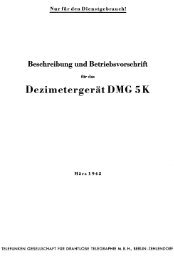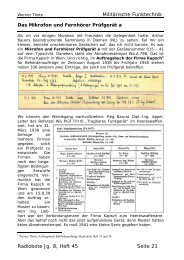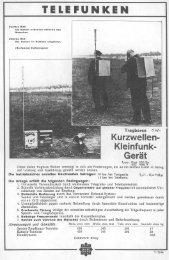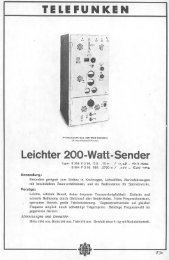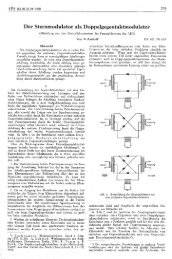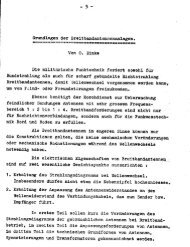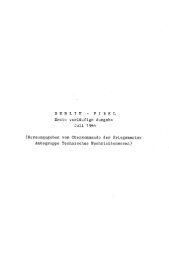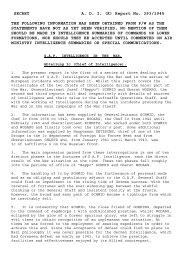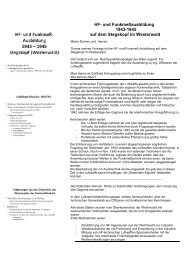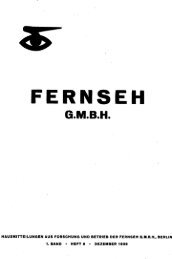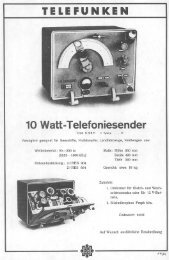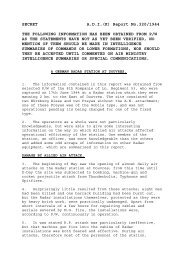SECRET A. D. I. (K) Report No. 357/1945. THE ... - Cdvandt.org
SECRET A. D. I. (K) Report No. 357/1945. THE ... - Cdvandt.org
SECRET A. D. I. (K) Report No. 357/1945. THE ... - Cdvandt.org
You also want an ePaper? Increase the reach of your titles
YUMPU automatically turns print PDFs into web optimized ePapers that Google loves.
100. Luftkurier was the first development of the Nachtlicht idea. It was primitive device<br />
intended to give visual indication to the pilot by means of a pointer which was started and<br />
stopped by the reception of pulses.<br />
101. P/W thought that Luftkurier was first tried out by K.G.66 on the Freya band, but it was so<br />
easy to jam by the addition of extra pulses that it was never developed.<br />
Nachtfee<br />
102. Nachtfee was the term used to describe a system for the transmission of control<br />
instructions to a pilot in the beam of the controlling Freya through the medium of a C.R.T.<br />
indicator similar to the Lichtenstein range tube. The airborne equipment used was known as<br />
FuGe 136 and weighed 12 kg.<br />
103. The original purpose of Nachtfee was, to provide a solution to the jamming of R/T control<br />
systems, and it had been used operationally by the Pathfinders of K.G.66 for mines in the<br />
Scheldt estuary. It was to be adapted for use by night fighters to overcome our jamming of the<br />
night fighter commentary.<br />
104. Nachtfee was a system using the FuGe 25A as receiver.<br />
105. The presentation screen in the aircraft was inscribed with various commands both on the<br />
inside and outside of a circular time trace. There was a stationary zero blip in the 12 o'clock<br />
position, and when an instruction was radiated the pulses received caused a second blip to<br />
emerge from the first and travel round the C.R. tube in a clock-wise direction, presumably by a<br />
slight change in p.r.f. This blip came to a stop and the command corresponding to its position<br />
could be read off on the inside of the time trace where a total of about eight different<br />
instructions were inscribed. It took from one to two second, for the blip to travel round the<br />
tube.<br />
106. It was thought that the further eight commands inscribed on the outside of the time trace<br />
were denoted by the blip making a complete circle starting round a second time before coming<br />
to rest at any one of the eight sectors. In this way a total of sixteen different orders could be<br />
given. For night fighters such instructions as "turn left/right", "climb", "dive”, etc. appeared on<br />
the inner side and figures for transmitting bearing on the outer side of the trace.<br />
107. This system was used operationally, but it was found that, apart from the susceptibility to<br />
jamming, other pulse transmissions could interfere by unlocking the system and thereby cause<br />
wrong positioning of the indicator blip.<br />
108. Another pronounced objection to the Nachtfee lay in the fact that it was necessary for a<br />
member of the crew to watch the C.R.T. indicator uninterruptedly for missing one blip<br />
indication might give the message a false value. It was not therefore possible to use it in singleseater<br />
aircraft.<br />
Barbara<br />
109. This apparatus, also called FuGe 138, consisted of an attachment to the FuGe 25A<br />
receiver and only weighed 2 kg. This unit contained an audio filter which allowed the pilot to<br />
hear morse signals superimposed on the Freya interrogator transmission if they were emitted on



